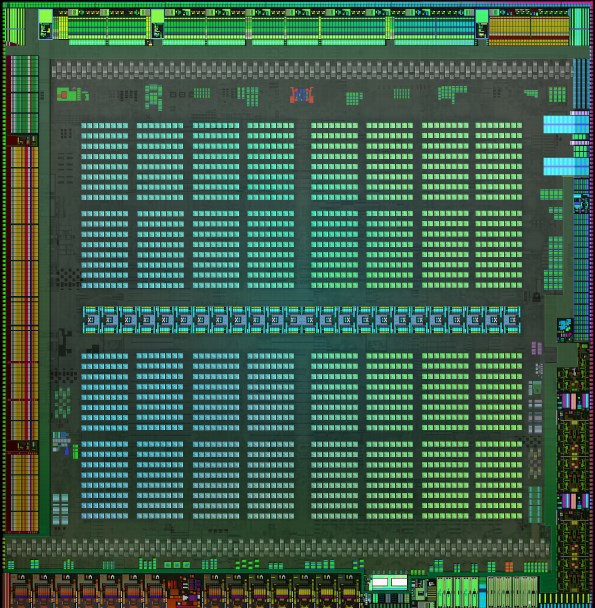Mobile Maxwell: NVIDIA Outs GeForce GTX 980M, 970M
Introduction
When NVIDIA launched the powerful GTX 980 and 970 last month, it was obvious that these cards would be coming to mobile sooner rather than later. The significant leap forward that Maxwell offers in performance-per-watt means that these GPUs would shine in mobile contexts -- maybe even more than in desktop.

The mobile Maxwell die
Today, NVIDIA is putting paid to that hypothesis with two new mobile GPUs -- the GeForce GTX 970M and 980M. Both cards are based on Maxwell's 28nm architecture, and both are trimmed slightly from the full desktop implementation. The GeForce GTX 980M is a 1536-core chip (just like the GTX 680 / 680M) while the GTX 970 will pack 1280 cores. Clock speeds are 1038MHz base for the GTX 980M and 924MHz for the GTX 970M -- significantly faster than the GTX 680M's launch speeds. The 980M will carry up to 4GB of RAM, while the 970M will offer 3GB and a smaller memory bus. From eyeballing relative performance, the 970M should be well-suited to 1080p or below at high detail levels, while the 980M will be the GPU of choice for Ultra detail at 1080p or higher resolutions at lower detail levels (more on this later).
The Maxwell GPU's superior efficiency means that it should offer a significant performance improvement over Kepler, even with the same number of cores. Clock speeds are also up sharply from the previous generation -- the older GeForce GTX 680M and GTX 780M were clocked at 720MHz and 823MHz respectively, while the 980M is running 26% faster.

All of these improvements are aimed at closing the gap between mobile and desktop GPU performance, and pushing above the 1080p mark. We'd advise against reading the graph above too optimistically -- the advantage of using fat computer icons to represent data points is that it makes the gap look smaller than it is. NVIDIA's FAQ states that the GTX 980M should perform at roughly 75% the performance of the GTX 980. Even that seems low, given that the GTX 980 desktop packs 33% more cores as well as higher clock speeds, but it doesn't change the fact that the gap between the two platforms is shrinking over time.
All of the GTX 980 features that we discussed in our initial review are present in the new cards as well. Dynamic Super Resolution will be added in a future update, as will support for the new MFAA antialiasing standard. Other capabilities, like the VXGI voxel acceleration engine that NVIDIA is pushing hard as a major feature of the Maxwell family are also supported, though no games that we're aware of have yet announced support for the product.

The mobile Maxwell die
Today, NVIDIA is putting paid to that hypothesis with two new mobile GPUs -- the GeForce GTX 970M and 980M. Both cards are based on Maxwell's 28nm architecture, and both are trimmed slightly from the full desktop implementation. The GeForce GTX 980M is a 1536-core chip (just like the GTX 680 / 680M) while the GTX 970 will pack 1280 cores. Clock speeds are 1038MHz base for the GTX 980M and 924MHz for the GTX 970M -- significantly faster than the GTX 680M's launch speeds. The 980M will carry up to 4GB of RAM, while the 970M will offer 3GB and a smaller memory bus. From eyeballing relative performance, the 970M should be well-suited to 1080p or below at high detail levels, while the 980M will be the GPU of choice for Ultra detail at 1080p or higher resolutions at lower detail levels (more on this later).
The Maxwell GPU's superior efficiency means that it should offer a significant performance improvement over Kepler, even with the same number of cores. Clock speeds are also up sharply from the previous generation -- the older GeForce GTX 680M and GTX 780M were clocked at 720MHz and 823MHz respectively, while the 980M is running 26% faster.

All of these improvements are aimed at closing the gap between mobile and desktop GPU performance, and pushing above the 1080p mark. We'd advise against reading the graph above too optimistically -- the advantage of using fat computer icons to represent data points is that it makes the gap look smaller than it is. NVIDIA's FAQ states that the GTX 980M should perform at roughly 75% the performance of the GTX 980. Even that seems low, given that the GTX 980 desktop packs 33% more cores as well as higher clock speeds, but it doesn't change the fact that the gap between the two platforms is shrinking over time.
All of the GTX 980 features that we discussed in our initial review are present in the new cards as well. Dynamic Super Resolution will be added in a future update, as will support for the new MFAA antialiasing standard. Other capabilities, like the VXGI voxel acceleration engine that NVIDIA is pushing hard as a major feature of the Maxwell family are also supported, though no games that we're aware of have yet announced support for the product.







